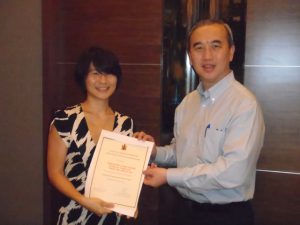Meet the Researchers: Dr. Choo Hyekyung
June 13, 2011
Dr. Choo Hyekyung, (Social Work) recently received the Annals, Academy of Medicine Best Publication Silver Award 2010, based on her co-authored article ‘Pathological Video-Gaming among Singapore Youth’.
This important new work understandably drew the attention of the media and is a topic which continues to generate much discussion, not only in academic circles. Below Dr Choo shares more about the project and the wider implications of internet gaming and its study.

How did you become involved in this research project?
Shortly after I joined FASS in 2005 I was approached by Angeline Khoo (NIE) who was looking for collaborators. My background involved working with young people, many with health issues, addictions and psycho-social issues so I was a good match for the project. My co-authors have different backgrounds in psychology, new media and paediatric psychiatry and are based here, Hong Kong and in the USA, so it was a very rewarding experience working with such a multidisciplinary team.
Can you tell us more about the project’s design and initial findings?
The project was funded by the MOE and MDA and ran as a longitudinal study over three years. We followed about 3000 boys and girls in six primary and six secondary schools in Singapore. The youths responded to a survey questionnaire on their socio-demographic characteristics, video-gaming habits, school performance, somatic symptoms, various psychological traits, social functioning and pathological symptoms of video-gaming. After weighting, the survey data were analysed to determine the prevalence of video-gaming addiction among Singapore’s youth. What we found was that of all the study participants, 8.7% were classified as pathological players. More boys (12.6%) reported pathological symptoms than girls (4.7%). These addicts spend about 37.5 hours a week gaming – double the 18.8 hours spent by non-addicted youths. We found that certain behaviours were significantly associated with pathological status; these include an impulse control problem, reduced social competence, increased hostility, poor academic performance, and damage to social functioning. Actual addiction is not really about how many hours a day you are playing games but about how the game-playing impacts other aspects of your life. We also found that the prevalence of pathological video-gaming among Singaporean youth is comparable with data from other countries, although such longitudinal data is rare internationally.
Does this mean we can draw conclusions about the negative effects of gaming on youths today?
We can’t draw real cause and effect conclusions from the data presented in this particular paper- it is more a snapshot of the state of affairs now. However, my co-author Douglas Gentile of Iowa State University presented a paper earlier this year that argued that pathological gaming may result in mental health problems. His paper invited a lot of controversy and fuelled the ongoing debate in academia between researchers and clinicians as to whether gaming addiction really is a ‘problem’ which needs solving. There is also some evidence that some researchers who receive their funding from the gaming industry itself may present a more favourable view of the benefits of gaming as an activity.
What does this award mean to you?
The award is significant in that it endorses the construct validity of instrument we used to measure the pathological symptoms of video-gaming. We used criteria adapted from the Diagnostic and Statistical Manual (DSM IV) of Mental Disorder for pathological gambling. This is because there are overlapping features between pathological gambling and any type of electronic gaming. This award is great because it belongs to the whole team, to everyone who contributed.
What can we expect next from this study?
I’m very excited about the future possibilities stemming from this research, particularly in knowing how to intervene with those young people who are addicted. We have more data still to be fully presented which can be derived from our study, some on eyesight, health issues and the different types of games played. The whole phenomenon is largely underfunded and under-researched so there is great potential in the years ahead.
